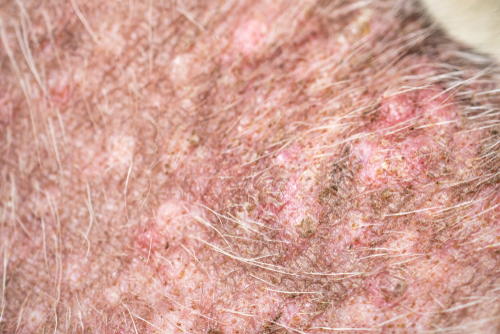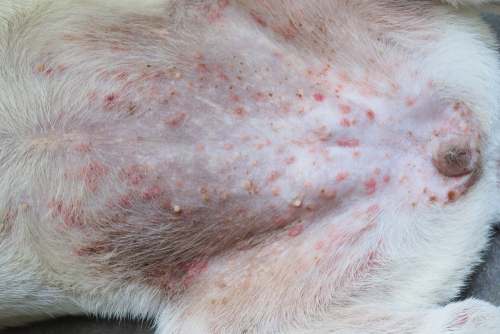
This article was updated on December 16th, 2023

If you’ve recently discovered a new dark spot on your dog’s belly, you’re likely scared for your dog’s health. In this article, we’ll review when belly color changes are benign and when they are a reason to be concerned.
Key Highlights:
– Brown spots on your dog’s belly could be part of their normal coloring
– If the dog’s skin is also red or flakey and your dog’s energy levels are affected, it could be a cause for concern
– Allergies, parasites, injuries, and hypothyroidism are more serious causes
– Check-in with your veterinarian during your dog’s routine exam to make sure the spots are normal
Our veterinarians Dr. Chyrle Bonk and Dr. Jamie Whittenburg share 5 things to know about belly spots.
5 things to know:
1. Most brown or black spots on a dog’s belly are not a reason for concern
“In my veterinary practice, I’ve commonly seen dark black or brown spots appear on a dog’s belly or stomach. Luckily, most cases of bellies turning black or brown are nothing to worry about. That being said, it’s important to not discount the fact that these new spots could also indicate a more serious health issue.”
Normal brown spots on a dog’s belly can be perfectly normal, for example when they are the result of skin coloring, age spots, or sun exposure. Some dogs are born with dark spots on the skin as a normal part of their skin coloring, as shown in the picture below:
For other dogs, dark spots can develop on their bellies as they age. In the picture below, you can see the natural “pink” color of the dog’s stomach next to a darker brown area that developed with age. Both colors are normal.
Beyond aging, black or brown spots on your dog’s belly or stomach can be the result of other benign reasons such as sun exposure, environmental changes, or new medications.
“If your dog recently started a new medication or if you’ve noticed a gradual increase in dark spots as your pup has aged, these are likely NOT a cause for concern. Be sure to keep an eye on these new spots for any sudden changes in size, shape, texture, or color, and see your veterinarian if you’re at all concerned.”
However, as we see in the next section, belly spots can also be the sign of a serious medical condition. Let’s take a look!
2. Brown spots on the belly are a reason to see the vet if you also notice scaly, red, or itchy skin
“Redness, itchiness, and changes in textures can be signs of a skin infection or irritation. Call your vet as soon as possible if you notice these signs or your dog’s belly skin appears to be rough, scaly, or crusty.”
The three pictures below show examples of dog bellies with rough, crusty, or red areas (besides black or brown spots on the belly). This indicates that an underlying medical condition is causing these skin issues and spots.



If your dog is often scratching or licking the area, read our article about “Itchy Black Spots on Dogs“.
Note that the examples above show fairly serious cases. If your dog’s belly is showing any signs of irritation or itchiness—even when it’s not as dramatic as the examples above—you should still consult with your vet to make sure that the condition doesn’t get worse for your dog.
Your dog may also require veterinary help if they experience a change in behavior, appetite, or activity level (for example, if your dog is not as energetic as usual), or if they are showing any other signs of discomfort or illness.
3. Medical conditions that cause black or brown spots include skin infections and allergies
While the spots on your dog’s belly are likely normal, changes to their skin color can also be the result of a medical condition that needs veterinary intervention. Let’s review the most frequent medical conditions that can cause a dog’s belly to change color:
- Skin infections or irritations
- Allergies
- Parasites
- Injuries
- Endocrine disease or disorders such as hypothyroidism
Less common medical conditions include:
- Cushing’s disease
- External environment changes
- Cancer
If you notice changes in your dog’s belly color, monitor them closely. Even if the spots aren’t bothering your dog, continue to monitor their behavior. Contact your vet immediately if the colors change in size or shape.
4. A vet should evaluate your dog’s belly during a routine exam
Even if the black or brown spots on your dog’s belly haven’t changed in size, shape, or texture, and your dog’s behavior seems normal, you should still check in with your veterinarian during a routine exam. Your vet will likely be able to evaluate if the spots are a serious issue.
If your vet is uncertain about a diagnosis, they may request a sample from your dog. This typically involves a skin scraping, fine needle aspirate, or even a biopsy.
From there, treatment will be started, if necessary, depending on the cause. Look to spend anywhere from $200 to $500 for diagnosis.
5. In the case of infection or allergies, treatment is important to prevent further damage to the skin
“Most cases of black spots or brown spots on a dog’s belly won’t need treatment. They could be a normal part of aging or sun exposure. However, if the spots are showing up because of irritation related to allergies, infection, or parasites, those conditions will need to be treated in order to prevent further color changes and damage to the skin. Your dog will need veterinary help.”
If the skin changes on your dog’s belly are due to an endocrine disorder or something like Cushing’s disease, you’re going to notice an array of other signs, including weight gain, increased appetite, hair loss, and cold intolerance, to name a few. These issues will require more extensive diagnostics and lifelong treatments.
This goes to show that you don’t want any changes in your dog’s skin to go undiagnosed and treated.
Melanin accumulation can cause dark or brown-colored spots on your dog’s belly
Melanin is a dark pigment that can be found in your dog’s skin and coat. The more melanin your dog has, the darker their skin and hair. When dark pigmentation clusters together, it can create a dark black or brown spot wherever the clusters occur—like your dog’s stomach.
In typical cases, this clustering of melanin is caused by aging or sun exposure which can put your dog’s skin cells into repair mode. When this happens, the melanocytes in your dog’s skin produce more melanin than usual. As the melanin accumulates, you can find more dark, black, or brown-colored spots on your dog’s body.
Related post: Black or brown spots in dog’s eyes
Disclaimer: This website's content is not a substitute for veterinary care. Always consult with your veterinarian for healthcare decisions. Read More.



Be the first to comment